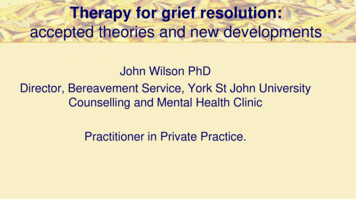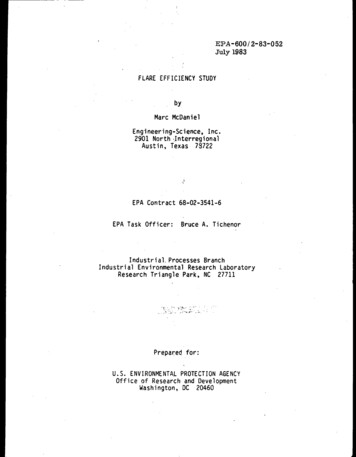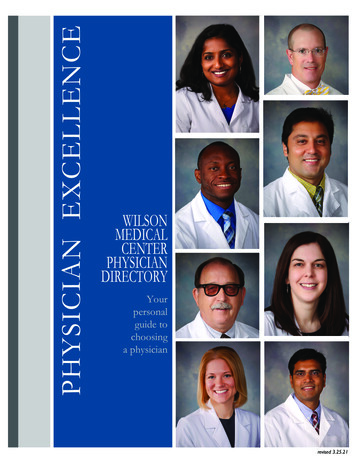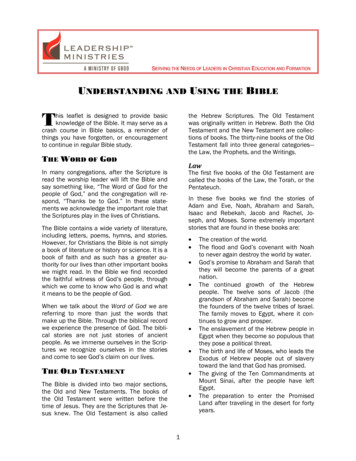
Transcription
Therapy for grief resolution:accepted theories and new developmentsJohn Wilson PhDDirector, Bereavement Service, York St John UniversityCounselling and Mental Health ClinicPractitioner in Private Practice.
Ground rules Confidentiality. Things said stay with you. Professionals together, soi)Please ask questions.ii) Please share examples if you can do so ethically. I have to maintain responsibility for timing. If at any point, the session ‘presses your buttons’ feelfree to take time out.
Historical perspectivesSigmund Freud Mourning and Melancholia (1917, 1957) Melancholia not inevitable following bereavement. Grief a normal process. Melancholia in those of a‘pathological disposition’.
Historical perspectivesSigmund Freud Libido becomes bound to the lost love object. Only bybreaking this bond can a person be freed from his grief.The process Freud called ‘grief work’.
Historical perspectivesHelene Deutsch Four bereaved patients for whom there was “a completeabsence of the manifestations of mourning” (Deutsch,1937, p. 12). Deutsch drew on Freudian concepts to explain her beliefthat these patients may have been avoiding grief, and thatthis avoidance was pathological.
The Cocoanut Grove FireBoston, 19421000 peoplewere inside.492 died, 160were injured.
Historical perspectivesErich Lindemann Boston psychiatrist and psychoanalyst Erich Lindemanntreated many of the families of the victims. In 1944 he published a highly influential paper entitledSymptomatology and Management of Acute Grief.
Historical perspectivesGeorge Engel In 1961 George Engel MD wrote an article which heentitled Is grief a disease? Engel listed the commonly observed symptoms of grief. Ifthese were seen as a disabling syndrome then ‘yes’ heconcluded, grief is a disease. If grief was seen as a disease, this validated clinicalintervention
Historical perspectivesJohn William Worden From the idea of Stages of Grief, Worden developed TheTasks of Mourning. The various edition of his book allinvolve versions of ‘letting go’ of the deceased.
Worden’s Task Model of GriefTask 1 Accepting the reality of the loss,Task 2 Experiencing the pain of grief,Task 3 Adjusting to an environment in which the deceasedis missing,Task 4 Letting go.
John BowlbyWorked with Colin Murray Parkes at theTavistock Clinic. Together they developeda four-phase model of grief:1. Numbness2. Yearning and searching3. Disorganisation and despair4. Greater or lesser degree of reorganisation.(Bowlby & Parkes, 1970)
Parkes (2009) hassince written thatthis phase modelwas theoretical, andnever intended to beused prescriptivelyby counsellors
Bereavement counselling:The issues for private practitioners:1. Given appropriate reassurance, most bereaved people do not needcounselling for their grief2. Bereavement counselling has not been shown to be effective,except for the most severe cases of grief. It may also do harm3. For some clients, there are benefits in avoiding emotions andkeeping busy4. There is no evidence that all clients need to do ‘grief work’ as partof their recovery5. Arguably, working with a client’s grief when it is not needed andunlikely to bring benefits, is ethically analogous to a doctorprescribing antibiotics for a viral infection.
Bereavement counselling:The issues for private practitioners:Our challenge is to identify who we need to work withand how we go about it.
1. Given appropriate reassurance, most bereavedpeople do not need counselling for their griefChronic griefRecoveryResilience16%11%46%73%A further 18% exhibitedpre-loss depression9% were unclassifiedBonanno, Boerner & Wortman(2008)
2. Bereavement counselling has not been shown to beeffective, except for the most severe cases of grief Schut, Stroebe, Van den Bout and Terheggen (2001),concluded that routine referral for bereavementcounselling is highly unlikely to be effective. There issome evidence that counselling may do harm.
3. For some clients, there are benefits in avoidingemotions and keeping busy
Does grief counselling help? On the other hand, they found that intervention offered tobereaved persons at risk of developing complications wasfound to be modestly effective, but only short term, whilegrief therapy for persons suffering from complicated griefwas proven to be effective, also longer term (ibid).
4. There is no evidence that all clients need to do‘grief work’ as part of their recovery From Freud to John Bowlby (1969) the concept of ‘griefwork’ had become firmly established. Failure to do ‘grief work’ was seen as maladaptive,Bereavement counselling was about helping bereavedpeople to do their “Grief Work” (Stroebe 2002).
Doubts about ‘grief work’ Camille Wortman and Roxane Silver (1980) questionedthe validity of the concept. The Myths of Coping with Loss (Wortman & Silver, 1989).Questioned that failure to do grief work was indicative of apathological condition.
Is ‘grief work’ really necessary?Stroebe (2011) defined Grief work as:“The process of emotionally confronting the reality of the loss, ofgoing over events that occurred before and at the time of death,and of focusing on memories and working toward detachmentfrom the deceased.”
Criticism of the ‘grief work’ hypothesis Margaret Stroebe, “lack of conceptual clarity” engenderedby the term Lack of rigorous scientific evidence that Grief Work iseffective “Benefits of denial” (Stroebe 2011) Accumulated evidence from empirical research onbereaved people in Western (c.f. Stroebe 2002) andBalinese (Wikan 1990) cultures suggests Grief work isneither nor beneficial
So where do we go from here?Given the history of therapeutic interventions, and evidencewe have considered so far, where do we go from here?Exploration and appraisal of contemporary models of griefmay help
Assumptive World Theory Conceived by Colin Murray Parkes (1971) Developed by Ronnie Janoff-Bulman (1992)
Finding meaning, Making senseThomas Attig (2001, 2011) Grief as the relearning of a complex world throughthe interplay between meaning making andmeaning finding. The relearning involves how to be and actin the world without the person we loved.
Finding meaning, Making senseBob Neimeyer’sideas arehugelyinfluential
Finding meaning, Making senseNeimeyer (2009) “The storied nature of human life”. Life is accompanied by a continuing self-narrative, by whichwe organise our understanding of day-by-day events. Significant loss or trauma disrupts the self-narrative processso that it may become totally disorganised. The grieving person may even dissociate from their selfnarrative. Unhelpful self-narrative can lead to rumination anddepression.
Grief and Growth. Lois Tonkin(2007)
Grief and Growth. Lois Tonkin(2007)
Dual Process ModelStroebe & Schut 1999Reproduced here with permission from the authors
Continuing Bonds Klass et al (1996) suggest that, in many instances, thegrief process does not end but rather undergoesongoing adaptation and change. Memorializing, allowing lost loved ones to influence thepresent. Not living in the past, but recognisinghow past bonds can inform our presentand future.)
John’s research:The research is predicated on the Meaning-makingparadigm, which posits that clients make sense of theirsituation/environment by constructing meaning in the formof schemas, through a process of assimilation andaccommodation.Thus the role of the counsellor is to foster and encouragethis process.The role of the researcher is to observe, analyse and chartthe development of meaning-making schemas.
John’s research:The process of change is observed and charted on TheAssimilation of Grief Experiences Scale, AGES (Wilson2017), a refinement of The Assimilation of ProblematicExperiences Scale, APES, devised by Bill Stiles (2001).
Assimilation of Grief Experiences Scale
Assimilation of Grief Experiences Scale
John’s research:My research points to the fact that that usually resilientexperiencing problematic grief are helped if they can:i) accept the reality of the death, including being able to talkabout it in detail,ii) make sense of the death,iii) acquire and practice coping strategies. At best this involvesoscillating between grief and restoration orientation (Distractionand avoidance can play an important part in this),iv) accept that for a time, sadness will be ‘as good as it gets’,
John’s research:My research points to the fact that that usually resilientexperiencing problematic grief are helped if they can:v) find meaning in a life without the deceased,vi) anticipate (eventually) a positive future without the lovedone. This may include an individualised and creativecontinuing bond with the deceased: moving forward in acontinuing symbolic relationship, rather than hankering forand clinging onto a lost past.
Complicated griefNothing exercises grief theorists and to some extent practitioners,more than the thorny subject of complicated grief.The pros and cons of accepting or rejecting the concept arecomplex, and to a degree academic.The concept may be helpful in some fields of health economics.Many practitioners see the concept as medicalising grief Many theorists claim that its existence as an observablephenomenon has yet to be proven.
A working definitionA clinically-significant deviation from the (cultural) norm (i.e. that couldbe expected to pertain, according to the extremity of the particularbereavement event) in either (a) the time course or intensity of specific orgeneral symptoms of grief and/or (b) the level of impairment in social,occupational, or other important areas of functioning.(M.S. Stroebe, Hanson, Schut, & Stroebe, 2008, p. 7).
Features of normal, healthy grief sadness, shock, disbelief, pangs or waves of grief,yearning, obsessive thoughts, rumination, changed sleeppatterns, confusion, difficulty in concentrating, anger,anxiety, guilt, changes in appetite, social withdrawal, vividdreams, sensing the presence of the deceased,hallucinatory experiences.
Features of prolonged grief disorder sadness, shock, disbelief, pangs or waves of grief,yearning, obsessive thoughts, rumination, changed sleeppatterns, confusion, difficulty in concentrating, anger,anxiety, guilt, changes in appetite, social withdrawal, vividdreams, sensing the presence of the deceased,hallucinatory experiences. Lasting more than 6 months
Bonanno’s trajectories revisitedChronic griefRecoveryResilience16%11%46%73%A further 18% exhibitedpre-loss depression9% were unclassifiedBonanno, Boerner & Wortman(2008)
Complicated or complicating? A consideration of the factors complicating grief may be abetter guide. Many practitioners and some researchers consider that itmay be better to talk about normal grief, or commongrief, complicated by circumstances. Although the difference could be considered semantic, itcan avoid the risk of medicalising grief reactions.
Inventory of Complicated grief Invasive thoughts that disrupt day to day life,Upsetting memories,Disbelief and difficulty in accepting the reality of the death,Longing for the deceased,Being drawn to places associated with the deceased,Feeling angry about the death,Feeling stunned or dazed, experiencing a loss of trust in others,Exhibiting a loss of empathy for, and distancing self from others,Suffering pains similar to that experienced in the deceased’s finalillness, Avoiding reminders of the lost person, Feeling that without the deceased, life is empty and pointless.Prigerson 1995
Complicated grief & ICD-11 The World Health Organisation (WHO)International Classification of Diseases (ICD)Edition 11, classifies Prolonged Grief as adisorder. The Diagnostic & Statistical Manual ofMental Disorders, 5th Edition, published by theAmerican Psychiatric Association in May 2013,rejected pressure from some quarters, to includeprolonged grief as a disorder. As in DSM-IV,grief is recognised as a possible trigger to amajor depressive episode.
Complicated grief & DSM-6 Word on the bereavement counselling grapevine isthat prolonged grief disorder will be recognised inDSM-6.
A detailed discussion on the nature ofgrief and grief counselling, includingcomplicated grief, can be found in mybook.
QUESTIONS ?
Thanks for participatingJohn ng.co.uk
ReferencesAttig, T. (2001). Relearning the World: Making and finding meanings. In R. A.Neimeyer (Ed.), Meaning Reconstruction & the Experience of Loss (pp. 33-53).Washington DC: American Psychological Association.Attig, T. (2011). How We Grieve: Relearning the World (Revised ed.). Oxford:Oxford University Press.Bonanno, G. A., Boerner, K., & Wortman, C. B. (2008). Trajectories of grieving.In M. S. Stroebe, R. O. Hansson, H. Schut & W. Stroebe (Eds.), Handbook ofBereavement Research and Practice: Advances in Theory and Intervention (pp.287-307). Washington DC: American Psychological Association.Bowlby, J. (1969). Attachment and Loss: Volume 1 Attachment. London:Pimlico.
ReferencesBowlby, J., & Parkes, C. M. (1970). Separation and loss within the family. In E.J. Anthony & C. Koupernik (Eds.), The child and his family (pp. 197-216). NewYork: Wiley.Deutsch, H. (1937). Absence of grief. The Psychoanalytic Quarterly.Engel, G. L. (1961). Is grief a disease? A challenge for medical research.Psychosomatic Medicine, 23, 18-22.Freud, S. (1957). Mourning and melancholia (original work published in 1917)(J. Strachey Ed. Vol. 14). London: Hogarth.Janoff-Bulman, R. (1992). Shattered Assumptions: Towards a New Psychologyof Trauma. New York: The Free Press.Klass, D., Silverman, P. R., & Nickman, S. L. (1996). Continuing Bonds: NewUnderstandings of Grief. Philadelphia: Taylor & Francis.
ReferencesLindemann, E. (1944). Symptomatology and Management of Acute Grief.American Journal of Psychiatry, 102(2), 141-148.Neimeyer, R. A. (2009, 7/14/2009). Conference workshop. Paper presented atthe Researching Meaning-Making: Narratives of Grief and Loss., St Ann'sCollege, Oxford.Parkes, C. M. (1971). Psychosocial transitions: a field for study. Social Scienceand Medicine, 5, 101-115.Parkes, C. M. (2009). Love and loss: The roots of grief and its complications(Paperback ed.). Hove: Routledge.Prigerson, H. G., Frank, E., Kasl, S. V., Reynolds III, C. F., Anderson, B.,Zubenko, G. S., . . . Kupfer, D. J. (1995). Complicated grief and bereavementrelated depression as distinct disorders: Preliminary empirical validation inelderly bereaved spouses. American Journal of Psychiatry, 152(1), 22-30.
ReferencesSchut, H., Stroebe, M. S., van den Bout, J., & Terheggen, M. (2001). TheEfficacy of Bereavement Interventions: Determining Who Benefits. In M. S.Stroebe, R. O. Hansson, W. Stroebe & H. Schut (Eds.), Handbook ofBereavement Research: Consequences, Coping and Care (pp. 705 -737).Washington DC: American Psychological Association.Silver, R. L., & Wortman, C. B. (1980). Coping with undesirable life events.Human helplessness: Theory and applications, 279, 375.Stroebe, M. S., Hansson, R. O., Schut, H., & Stroebe, W. (Eds.). (2008).Handbook of Bereavement Research and Practice: Advances in Theory andIntervention. Washington DC: American Psychological Association.Stroebe, M. S., & Schut, H. (1999). The Dual Process Model of Coping withBereavement: Rationale and desciption. Death Studies, 23, 197-224.
ReferencesStroebe, M. S. (2011, 2/16/2011). The Dual Process Model: latest thinking.Paper presented at the Colin Murray Parkes Open Meetings. St Christopher'sHospice London 16th February 2011, St Christopher's Hospice,London.Stroebe, M. S., & Schut, H. (2001). Models of Coping with Bereavement: AReview. In M. S. Stroebe, R. O. Hansson, W. Stroebe & H. Schut (Eds.),Handbook of Bereavement Research: Consequences, Coping and Care (pp.375-404). Washington DC: American Psychological Association. (Reprintedfrom: In File).Stroebe, M. S., Stroebe, W., Schut, H., Zech, E., & van den Bout, J. (2002).Does disclosure of emotions facilitate recovery from bereavement? Evidencefrom two prospective studies. Journal of Consulting and Clinical Psychology,70(1), 169-178.
ReferencesStiles, W. B. (2001). Assimilation of Problematic Experiences. Psychotherapy,38(4), 462-465.Tonkin, L. (2007). Certificate in Grief Support: Extending Your Skills in WorkingWith Grieving Adults. Christchurch, New Zealand: Port Hills Press.Wikan, U. (1990). Managing turbulent hearts:a Balinese formula for living.London & Chicago: University of Chicago Press.Wilson, J. (2017). Moments of Assimilation and Accommodation in theBereavement Counselling Process. (PhD), Leeds, White Rose eTheses Online.Worden, J. W. (1983). Grief Counselling and Grief Therapy (1st ed.). London:Tavistock.Wortman, C. B., & Silver, R. C. (1989). The Myths of Coping With Loss. Journalof Counselling and Clinical Psychology, 57(3), 349-357.
counselling for their grief 2. Bereavement counselling has not been shown to be effective, except for the most severe cases of grief. It may also do harm 3. For some clients, there are benefits in avoiding emotions and keeping busy 4. There is no evidence that all clients need to do ‘










